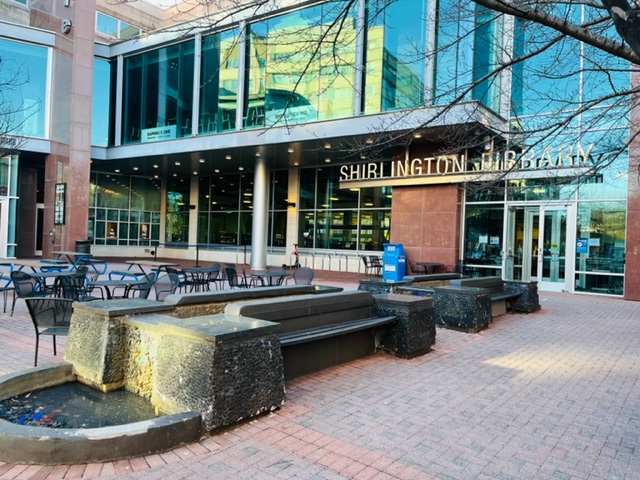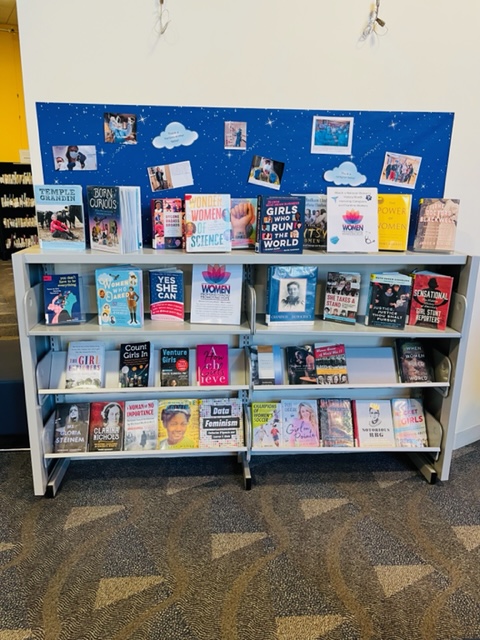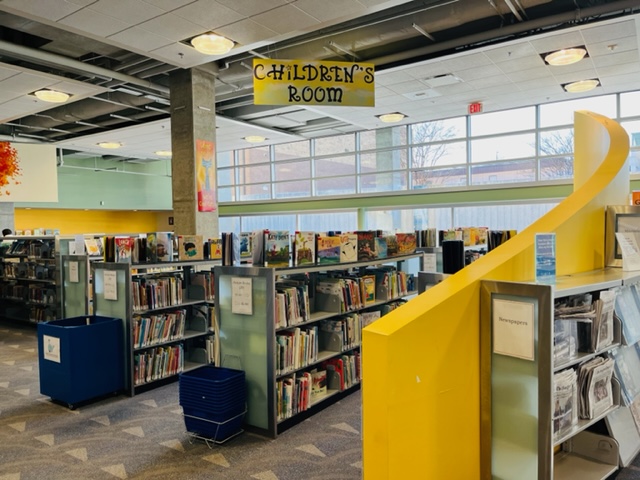
Shirlington Library is a small branch within Arlington Public Libraries. It is at the end of a street in a trendy, busy neighborhood filled with restaurants, bars, and shops. The building is sleek and modern, with a light-art installation on the right side of the building and a water mosaic art installation outside of the building. The building is shared with the Tony Award®-winning Signature Theatre. Outside of the library, there are multiple wrought iron tables and chairs, picnic tables, wooden lounge chairs, benches, bike racks, a small garden, and three book drops. The library is on the lower level of the building with floor-to-ceiling windows. The outdoor space is inviting and welcoming, with multiple seating options to socialize, read, or work. It gave me the impression that it is a place to stay and be comfortable, especially with the free wifi hotspots available outside the building.
Upon entering the library to the right was a book display featuring Women’s History Month. To the left were 20 public computers for patrons to reserve and the large circulation desk in the center. Arlington Public Library’s mission statement is, “we champion the power of stories, information, and ideas. We create space for culture and connection. We embrace inclusion and diverse points of view” (Arlington Public Library, n.d.). During my visitation, I was able to see their mission statement carried out in the physical spaces and the collection with collaboration spaces, a diverse collection both print and digital, and an equitable and inclusive space.

One of the first things I noticed was how this branch provides equitable service to people with disabilities. The ALA states that libraries must “support diverse collections that are responsive to those with disabilities, and that physical facilities are accessible” (ALA, 2019n, as cited in Rubin and Rubin, 2020, p.521). There are push buttons to activate all doors for mobility issues. The floor plan is open and minimal, the stacks are vast for wheelchair access, and the two highest and lower shelves were left empty. Additionally, there is a lower circulation desk for people in wheelchairs, little people, or children, and a lower catalog computer station for patrons. Magnification software is installed on each public computer, and the table heights are adjustable.
I was surprised how small the physical collection was but then remembered this is a smaller branch, and Arlington Public Library uses a floating collection system. I got the sense from observing how the physical space is used that patrons use this library as a workspace since most of the space was public computers, various seating areas, and a large meeting room/quiet study. As I looked around, hardly anyone was browsing the stacks. Instead, people were using the public computers, collaborating on projects at tables, or were working independently. What I appreciated most was the variety of seating options. Roll desk chairs, stationary hard chairs, comfortable lounge chairs, love seats, and solitary lounge chairs with a movable arm table attached. I set up a workspace in a lone lounge chair to observe the library and its patrons in use. Then I eventually moved into the large meeting room for a quiet study that I shared with one other patron the remainder of the time.
The two largest print collections were nonfiction (including biographies) and Adult. The signage was large and easy to follow, and the collection was organized by Dewey. Walking through the stacks was easy, and the flow was well planned. The condition of the books was excellent; nothing looked old, dirty, or outdated. The physical collection consisted of Adult, Adult Graphic Novels, Biographies, Books on CD, Children’s Lit, Detective, DVD’s, Large Print, Magazines, Newspapers, Books in Spanish, Teen, Teen and children graphic novels.
The children’s section was the second largest section in the library and took up most of the backspace. According to Rubin and Rubin (2020), “children’s materials represent more than 35% of total circulation” (p.110). The “Children’s Room” was bright and colorful with posters and artwork. It is evident that children’s lit is heavily used in this branch. In fact, the only place where patrons were browsing was in the children’s lit section. The shelves were lower, with rolling baskets for easy carrying of books. There were four low computer stations with noise-canceling headphones attached. I noticed Storytime kits, games, American Girl dolls, and Everyone books with CDs available for check out.

The Teen section was lacking. Despite “new” books featured, there were only two rows of stacks in the teen section. I was slightly disappointed by this because YA titles are some of my favorites to read. It also felt like an afterthought. During my observation, I did not see one teen in the library. This could be because this neighborhood is primarily comprised of diverse younger professionals and young families.
The library has a clean website that is easy to navigate for a first-time user. Most of the library’s resources are on the website, which reinforces Rubin and Rubin’s (2020) access to digital resources and services (p. 523). I was surprised by how many resources Shirlington Library offers. All services are provided in multiple languages. There are even services for patrons who are homebound such as “Books by Mail and Talking Books.” In addition, the library provides standard online services like getting a library card, browsing the catalog, requesting ILL’s, and checking your library account. There are also multiple online databases and services for specific interests. Some databases include Mango Languages, which offers over 70 languages to learn, Universal Class has over 500 free continuing education courses, Health & Wellness Resources Center, LinkedIn Learning offers 16,000 instructional videos taught by industry professionals taught in seven languages, and Novelist to discover fiction titles based on interests. Shirlington Library offers 48 research tools, including databases, periodicals, magazines, legal forms, and ancestry information.
Shirlington library offers in-person programming like storytime, book clubs, and scavenger hunts. Still, they also provide virtual programs like author talks, Big Book Club Podcast, virtual storytime, virtual language classes, and U.S. Citizenship classes.
I could locate special collections offered on the website like Family Reading Kits, Wireless Hotspots, Garden Tool Lending Library, LED Bulb Sampler, Thermal Cameras, and Electricity Usage Monitors. I found the LED bulb sampler kit extremely useful and placed a hold on one! Once online using the website was when I was able to see the abundance of resources available to patrons. In a 21st century library, it was clear to see the “digital divide” (IPAC, 2014, as cited in Rubin and Rubin, 2020, p. 96). While I appreciated the plentiful online resources at the touch of my fingertips, I could see this being problematic especially for patrons who do not have equal access to technology at home or do not possess the skills to use technology.
On my visit to Shirlington, five library employees were working. One library manager, who is the only person listed on Shirlington’s website, one librarian who possesses their MLIS, two library associates, and one library assistant. There were only two people on the floor at the circulation desk, meaning there was often a line at the circulation desk. Three out of the five employees were people of color, and the patrons in attendance were a diverse mix of people of color, elderly, children, and people who identify as white. As I exited the library, I paused to check out the bulletin board with many flyers for upcoming special events, author visits, and available book clubs.
References
Arlington Public Library. (n.d.). Library of things. https://library.arlingtonva.us/borrow/library-of-things/
Arlington Public Library. (n.d.). Research portal. https://library.arlingtonva.libguides.com/research
Arlington Public Library. (n.d.). Services. https://library.arlingtonva.us/services/
Arlington Public Library. (n.d.). Shirlington library. https://library.arlingtonva.us/locations/shirlington-branch-library/
Rubin, R. E. and Rubin, R. G. (2020). Foundations of library and information science (5th ed.). ALA Neal-Schuman.
Signature Theatre. (n.d.). About Us. https://www.sigtheatre.org/about/
Thank you for your extensive amount of information about the Shirlington Library, Stephanie! I have never visited this location, and after reading your detailed report, I would feel very comfortable walking into this particular library. Great observations about the access to the physical space, especially its handicapped accessible features. I was particularly impressed with your description of the Teen section. With such a small collection, I would be hard-pressed as a teen to spend much time at this library either! No wonder none of the patrons you saw were teens. I would also wonder if many of the teens prefer to read from the adult section or if maybe they have excellent collections at their high school libraries.
This is my local branch, but sadly, I never made the time to experience this location before this assignment fully. I would grab my holds, check out then leave. It was great to take the time to look around and see what my library offers. You bring up a great point about the teen section. It is entirely possible that teens are interested in adult or even the children’s area or have an excellent selection at their school libraries.
What a wonderful description of the library! However, I find it disappointing that the YA collection was small, especially after reading how robust the children lit section was. If the library wants to continue children’s love of reading, they need to furnish books that these children can read once they have outgrown the children section. I also think the special collections offered online seemed quite interesting. If I were a patron of that library, I would look into the Garden Tool Lending Library since I have never heard of anything like that before. Overall, the library sounds like it would be a wonderful place to visit; it definitely appears welcoming.
Hey Kat, I was pretty disappointed with the YA collection, especially since I enjoy reading YA literature. However, they did have new titles. Perhaps lack of space is also an issue since it is a smaller branch, and the county has a floating collection. Before my visit, I never knew they had a Garden Tool Lending Library, and I think it is a fantastic idea! Especially if you live in a condo like I do and lack storage space. I will be using that in the future!
The Shirlington Branch sounds delightful. I appreciated the various accessibilities for all people. I also couldn’t help but notice you mentioned multiple seating options for patrons, which allows people to feel welcomed. That was one thing I was disappointed about with my local library. Although this is a smaller branch in Arlington, it feels as though they strive to make the space inviting and valuable for all. I, too, would be disappointed with the small collection of YA books, which are also my favorite.
Hi Brittany, thank you for taking the time to read about Shirlington Library. It was great visiting with fresh eyes and walking around to all the locations I hadn’t realized were there before. My little branch offers a lot that I never realized was even available to patrons, like the Garden tools, but I wish the YA section were much more extensive.
I love so many things about this library! It’s location and the outside are very inviting. Also, it being shared with a wonderful theatre is such a clever idea! The book display for women’s history month is wonderful. I think it would bring to light more exposure for female authors and advocates. It also seems like they have paid extra attention to accessibility. I also found my public library to have a lacking selection for teens. Why do you think that is? I have a few theories, but I’m not for sure.
Hi Leslie, the library is small but mighty with resources for patrons. I believe one reason YA sections can be smaller in public libraries is that teens typically get their library resources from school; at least, that is my hope. We all know that budgets are tight, so perhaps the librarians who are developing the collection count on school libraries to carry the majority of required reading, new titles, and older titles.